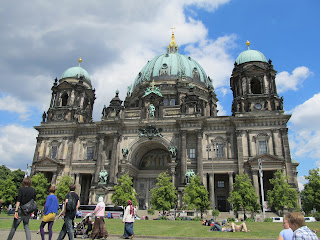Just like any other cathedral, the Berliner Dom has a lot of history. The first structure on this site was a chapel dedicated to St. Erasmus (who wrote Praise of Folly, which I wrote a paper on in my only English class in college, and made a copy of the Bible that scholars used for centuries, which I read about in my only book on New Testament textual criticism) in (wait for it...) 1465. 1465. That's a couple of decades before Columbus sailed over to America. Just to throw that into perspective there. Then, about three hundred years after that, they tore the chapel down to build a new cathedral in 1747. That cathedral was renovated in 1822 in the neoclassical style (to celebrate Prussia's uniting the Lutheran and Reformed communities). Next, Emperor Wilhelm II tore down that cathedral to build a new one in the baroque and renaissance styles that was finished in 1905, which was bombed during World War II and has since been renovated to show a simpler style, re-opening in 1993. And if you think that's a ridiculous amount of history, you should see the cathedral museum on the way up to the top of the dome. Ridiculous.
So the outside's deinitely impressive, with all these angels and then there are the fathers of the Protestant church (there's a lot of Luther) and there's Jesus, welcoming you in, and these gold inlay signs... it's a sight to see.
Inside, it's what I've come to expect from the older Catholic cathedrals I've visited- ornamentation, a decorated pulpit not in the center of the chancel, a crypt and a lot of biblical people looking down at you. Instead of the Latin or Greek church fathers, though, you have Protestant Reformers staring down at you. It's a little bit of a different experience.

 |
| Why hello there. |
Whenever people ask me what brings me to whichever city I happen to be in, I say travel unless I want to get into a discussion about religion and the church. There are many questions tied up in studying sacred architecture. I'm always afriad of Why do we need cathedrals? I'm always tempted to brush it aside as a power and pride thing, ostensibly insiting that people are trying to display the glory of God in a building, the same way Handel or Beethoven would try to display it in a composition. It's easier to do when it's a Catholic church because I'm not Catholic. It almost makes me curl up in a ball of ignorance and guilt when I think that I had assumed that Protestants of any kind wouldn't spend their time building these ornate buildings. And yet here we are, Luther and Calvin glaring down at me from the heights of the cathedral.
 |
| You might think I'm being dramatic, but really. They're staring. It's impolite. |
Climbing back down led to staircase after staircase and I ended up in the crypt, which, ironically, is right by the bathrooms. I dunno, I just feel like we shouldn't be waving the dullness of everyday living, breathing, existence in the face of our dead. I also feel like you shouldn't have a bathroom right beside a crypt of the honored dead, like kings and queens and war heroes. I mean, what kind of message does that send, especially to vindictive ghosts?
I liked the crypt, though. It was quiet and respectful. It's easy to mourn someone else's loss. I paused for a long time in front of the tiny caskets and pondered over the paired tombs of husbands and wives. The best part of the crypt, though, was its focus on promises. Following the main path will lead you from the entrance to either the exit, the tomb of an emperor, or a marble statue of a young man sitting on a marble bench in front of a cross draped with a white cloth.
On the bench beside the young man were the words Er ist nich hier, Er ist auferstanden. He is not here. He is risen.
I like it when I leave a church pensive. I like that the building has given me something to think about or turn over in my head. It gives me different ideas about the structure and purpose of a church, though, when the most meaningful places were the metal walkway high above the sanctuary and the cold crypt far below it.










No comments:
Post a Comment